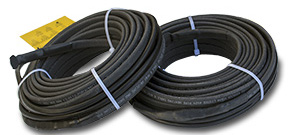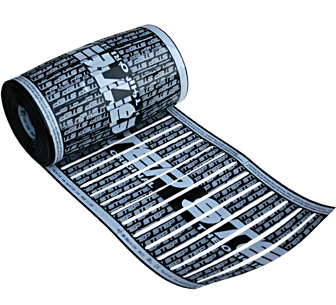Durango Roof Deicing and Gutter Heat Trace Systems
Winters can be tough on roofs in Durango, Colorado. With an annual average snowfall of 106 inches, roofs are on the front lines, bearing the brunt of Mother Nature’s cold season. While residential roofs can handle significant weight loads, they are still susceptible to a much more subtle winter problem – ice dams.
 Ice dams form as a result of heat escaping from the attic and warming the roof. The
runoff trickles down the roof, but when it reaches the eave – because there is no longer
any warmth from the attic – the runoff freezes, creating a ridge of ice. As this process
repeats, the ridge of ice increases in size, and before long the runoff can start to pool
behind the ice. Standing pools of water are the worst enemy of a roof. The water can seep
into every tiny imperfection and then refreeze at night. As this happens, the ice expands,
gradually breaking down the integrity of the roof over time. In some cases this can lead
to costly water damage in the home.
Ice dams form as a result of heat escaping from the attic and warming the roof. The
runoff trickles down the roof, but when it reaches the eave – because there is no longer
any warmth from the attic – the runoff freezes, creating a ridge of ice. As this process
repeats, the ridge of ice increases in size, and before long the runoff can start to pool
behind the ice. Standing pools of water are the worst enemy of a roof. The water can seep
into every tiny imperfection and then refreeze at night. As this happens, the ice expands,
gradually breaking down the integrity of the roof over time. In some cases this can lead
to costly water damage in the home.
Self-Regulating Heat Cable
When winter hits, some homeowners scramble to find a way to protect their roof gutters and downspouts from heavy ice buildup. Icicles can also create dangerous conditions for pedestrians below. Not only does falling ice present a danger, but melting icicles drip onto the sidewalk below and the water can refreeze at night, creating a thin sheet of slick ice. These are the conditions that business owners have nightmares about.
Most roof deicing solutions can be accomplished with self-regulating heat trace cable. The cable is installed in roof gutters and downspouts to prevent overwhelming ice loads from forming and keep runoff flowing freely. The cable can also be zigzagged along the roof edges to break up ice dams and keep pools of water from forming. Determining the ideal heat cable, thermostat and sensor depends on the size, type and construction of the roof, as well as the overall requirements of the particular installation.
 Self-regulating, parallel circuit, roof heating cable is one of the best radiant deicing
solutions. The cable features rugged construction and advanced technology, resulting in the
most effective solution for basic roof, gutter and downspout heating applications. Self-regulating
heat cable is also the most efficient.
Self-regulating, parallel circuit, roof heating cable is one of the best radiant deicing
solutions. The cable features rugged construction and advanced technology, resulting in the
most effective solution for basic roof, gutter and downspout heating applications. Self-regulating
heat cable is also the most efficient.
 The self-regulating aspect of the cable means that the power output of the irradiated
conductive core material can either increase or decrease in response to ambient temperature
changes. This adds to the safety and energy efficiency of the cable. This self-regulating
effect can occur at every point along the length of the cable to allow the heating element to
adjust to the different conditions along the length of the roof or gutter.
The self-regulating aspect of the cable means that the power output of the irradiated
conductive core material can either increase or decrease in response to ambient temperature
changes. This adds to the safety and energy efficiency of the cable. This self-regulating
effect can occur at every point along the length of the cable to allow the heating element to
adjust to the different conditions along the length of the roof or gutter.
Because the cable is self-regulating, it can be overlapped without creating hot spots or
causing a burnout within the heating element. Maximum energy efficiency is assured by producing
heat only when and where it is needed. Warmzone roof heating cable is UL recognized under the
 Appliance Wire Classification (file E 76498) and meets the requirements of Section 426 of the
National Electric Code (NEC). It is designed to withstand harsh winter environments.
Appliance Wire Classification (file E 76498) and meets the requirements of Section 426 of the
National Electric Code (NEC). It is designed to withstand harsh winter environments.
Low-Voltage Roof Deicing
Another industry leading roof deicing solution is Warmzone’s low-voltage RoofHeat STEP system. This advanced system features a unique polymer heating element that is also self-regulating. The heating panels are 12-inches wide (other sizes are available) and very thin, so they can be installed directly under the roof shingles or metal roofing.
Warmzone roof deicing systems can be customized to accommodate just about any roof type and configuration. We’ll carefully evaluate your project and offer the best solutions available. For more information, call Warmzone today at 888.488.9276.
